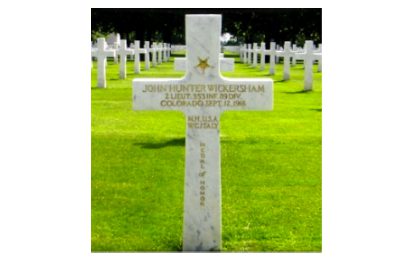Last year, I shared with you my thoughts after visiting some of the most notorious battlefields from the First World War. At St. Mihiel in France, I encountered America’s contribution to the war, making what I’d seen the previous two days at Verdun and Somme – key battles associated primarily with, respectively, the French and British – suddenly much more personal. Also making it personal, and painful, were the graves of the German-Jewish soldiers who died for the ‘Fatherland’ that less than two decades later would disown them.
Bitten by the battlefield bug, I decided this spring to visit the Belgian site of Ypres, where no less than five battles took place over the course of four years. The strategic salient in West Flanders is a microcosm of that war. Battle after battle. Terrain riddled with trenches and mine craters, the latter to this day. Front lines shifting by a matter of mere miles. Staggering loss of life. Acres upon acres of ravaged land, no building left standing, only burnt tree stumps dotting the landscape. The Second Ypres (1915) is infamous for being the battle where the Germans first used chlorine gas as a weapon of war. Ypres is also where the poem ‘In Flanders Fields’ – which inspired the adoption of the poppy as the symbol of remembrance – was penned by a Canadian army surgeon, John McCrae.

Like on my trip last year, I discovered that the Americans were also in Flanders. At the very tail end of the war, the 37th and 91st divisions fought both south and northeast of Ypres, in the areas of Oudenaarde and Kemmel Hill, pushing back the German line right through until the day the armistice was declared. In the American Flanders Field Military Cemetery (Belgium), Jewish headstones are found amidst the rows of crosses, and a beautiful limestone memorial to the American soldiers who fell in the battlefields of Flanders stands in the town of Oudernaarde, flanked by two proud bald eagles.
In the same town, but slightly further afield, is Ohio Bridge, from which the soldiers of the 37th division left for the battlefield. At each corner of the bridge stands a bison, symbolizing the strength of those American troops.
One style of monument that made a particularly strong impression were the stone walls inscribed with the names of those who fell “but to whom the fortune of war denied the known and honored burial given to their comrades in death.”* These bombastic monuments – such as Menin Gate in Ypres or Thiepval in France – inscribed with name upon name of those who died, but whose remains were never recovered, bring to life the words, also often found in war cemeteries, “Their names liveth forever more.”
I was reminded, of course, of the Vietnam Memorial, but also of the IJN’s annual Memorial Day insert, which lists the names of Colorado’s deceased Jewish veterans, including those killed in action. There’s something incredibly powerful about a name. Maya Lin, the designer of the Vietnam War Memorial, observed that unlike a photograph, which captures a specific point in time, a name captures an entire person; one begins to ponder that person’s story, where he came from, who he left behind, or, if he survived the conflict, where life took him.
I was also reminded of a haunting Holocaust memorial in Prague: the Pinkas synagogue, its walls inscribed with name upon name, an epitaph for the 80,000 Bohemian and Moravian Jews killed during the Holocaust (included in an IJN photo essay, Jewish Prague, Spring L’Chaim 2009).
Whether by coincidence or fate, both of my trips to the battlefields have taken place just before Memorial Day. Being fortunate enough to have no family that perished in an American war (although my maternal grandfather served during World War II and legend has it that a paternal great-great grandfather fought in the Civil War), I never before felt a strong connection to this day of commemoration. The heart-wrenching visits to the places where millions – among them Americans and Jews of all stripes and nationalities – met their tragic fate has changed all that. Memorial Day is no longer simply about a nice, long weekend, but about remembering and honoring those who gave the ultimate sacrifice.
*Taken from the inscription at Tyne Cot Cemetery, Belgium
A longer version of this essay will also appear in the IJN’s annual Memorial Day special edition, published May 23, 2014.













